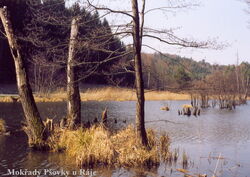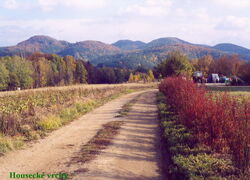Today, we have the second part of the Mácha Path (Máchova Cesta) ahead of us. Take the train from Mělník to Mšeno, that’s where you need to get off. So as not to follow the same trail as we did last time, we will head for the blue footpath across Močidla, a pristine ravine abundant in all sorts of bizarre rock formations, formed by ferruginous inlays in the local sandstone. A little detour will take us into the adjacent ravine, called Apatyka after its lush and multifarious vegetation. We will get on the red footpath at the Cikánský plácek below Pokličky (Capstones) – we’ll come here some other time, since today’s tour will lead us further along the Mácha Path to Housecké vrchy. And on we go through Vojtěchov, straddled with  timbered houses, and past the Pivovarský rybník (Brewer’s pond), draining its waters from the Stříbrník spring lodged in a rock crevice. Then we come to an intersection at Na Ráji, where you can treat yourselves to a really nice meal in two restaurants. The path turns off into the woods before the pool by Olešno, going past the Laka horse farm and there are still a couple of kilometers of climbing through Housecké vrchy left, till we reach the crossroads below Drnclík. From here we can follow the contour line all the way to the next crossroads – here is where the red footpath leading to Houska runs, formerly a castle, built in 1280-1290, and rebuilt in the style of Renaissance in 1590 into its today’s chateau look. Following the many years of being attended to and mainly being devastated by various national enterprises (having been nationalized), the chateau is once again open to public. Should you not be satisfied with the view out of the chateau windows, you can walk further onto the nearby Zámecký vrch with an observation point situated atop the rocks. The caved in cellars are remains of a church, which stood in the settlement around the castle in the 17th century.
timbered houses, and past the Pivovarský rybník (Brewer’s pond), draining its waters from the Stříbrník spring lodged in a rock crevice. Then we come to an intersection at Na Ráji, where you can treat yourselves to a really nice meal in two restaurants. The path turns off into the woods before the pool by Olešno, going past the Laka horse farm and there are still a couple of kilometers of climbing through Housecké vrchy left, till we reach the crossroads below Drnclík. From here we can follow the contour line all the way to the next crossroads – here is where the red footpath leading to Houska runs, formerly a castle, built in 1280-1290, and rebuilt in the style of Renaissance in 1590 into its today’s chateau look. Following the many years of being attended to and mainly being devastated by various national enterprises (having been nationalized), the chateau is once again open to public. Should you not be satisfied with the view out of the chateau windows, you can walk further onto the nearby Zámecký vrch with an observation point situated atop the rocks. The caved in cellars are remains of a church, which stood in the settlement around the castle in the 17th century.
 A path leads from Houska along a crest road to Kruh, a village priding itself on a Baroque church originating in the early 18th century, and then further on to Žďár, another village, this time an interesting sight for its array of timbered houses, grown into the sandstone rocks. Two kilometers further we come to a yellow footpath intersection. Having covered 20 kilometers since we set off in the morning - with the second third of the Mácha Path behind us - we turn off left, taking the yellow footpath. It is about a 10 minute walk before we get to Okna, a village with timbered houses and a Baroque church – here we’ll find the train station from which to get to Mladá Boleslav, where we can change to the local train to Mšeno, or Prague.
A path leads from Houska along a crest road to Kruh, a village priding itself on a Baroque church originating in the early 18th century, and then further on to Žďár, another village, this time an interesting sight for its array of timbered houses, grown into the sandstone rocks. Two kilometers further we come to a yellow footpath intersection. Having covered 20 kilometers since we set off in the morning - with the second third of the Mácha Path behind us - we turn off left, taking the yellow footpath. It is about a 10 minute walk before we get to Okna, a village with timbered houses and a Baroque church – here we’ll find the train station from which to get to Mladá Boleslav, where we can change to the local train to Mšeno, or Prague.
